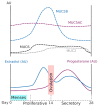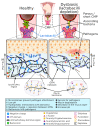The Cervicovaginal Mucus Barrier
- PMID: 33158227
- PMCID: PMC7663572
- DOI: 10.3390/ijms21218266
The Cervicovaginal Mucus Barrier
Abstract
Preterm births are a global health priority that affects 15 million babies every year worldwide. There are no effective prognostic and therapeutic strategies relating to preterm delivery, but uterine infections appear to be a major cause. The vaginal epithelium is covered by the cervicovaginal mucus, which is essential to health because of its direct involvement in reproduction and functions as a selective barrier by sheltering the beneficial lactobacilli while helping to clear pathogens. During pregnancy, the cervical canal is sealed with a cervical mucus plug that prevents the vaginal flora from ascending toward the uterine compartment, which protects the fetus from pathogens. Abnormalities of the cervical mucus plug and bacterial vaginosis are associated with a higher risk of preterm delivery. This review addresses the current understanding of the cervicovaginal mucus and the cervical mucus plug and their interactions with the microbial communities in both the physiological state and bacterial vaginosis, with a focus on gel-forming mucins. We also review the current state of knowledge of gel-forming mucins contained in mouse cervicovaginal mucus and the mouse models used to study bacterial vaginosis.
Keywords: bacterial vaginosis; cervical mucus plug; cervix; microbiota; mouse model; mucin.
Conflict of interest statement
The authors declare no conflict of interest.
Figures




References
Publication types
MeSH terms
Substances
LinkOut - more resources
Full Text Sources

